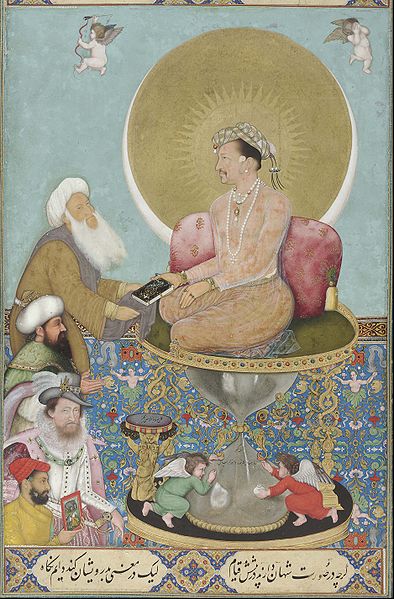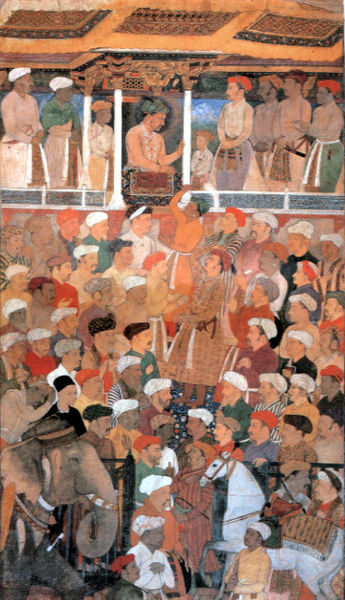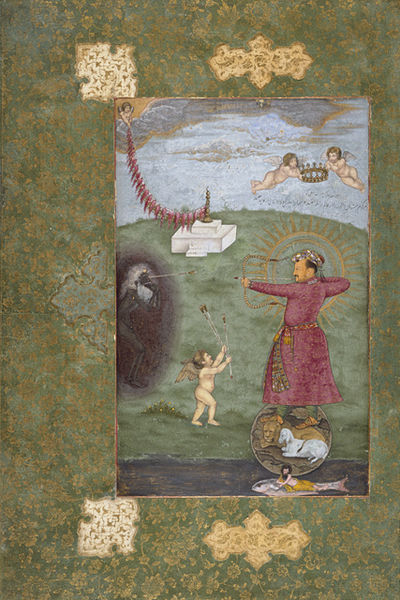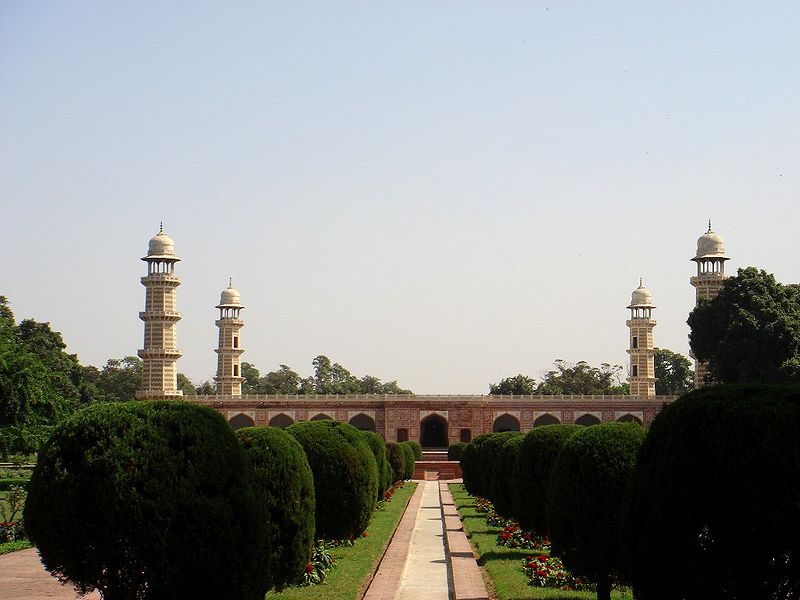<Back to Index>
- Archaeologist Luborg Niederle, 1865
- Composer José Maurício Nunes Garcia, 1767
- 4th Mughal Emperor of India Nur-ud-din Salim Jahangir, 1569
PAGE SPONSOR



Nur-ud-din Salim Jahangir (Persian: نورالدین سلیم جهانگیر) (full title: Al-Sultan al-'Azam wal Khaqan al-Mukarram, Khushru-i-Giti Panah, Abu'l-Fath Nur-ud-din Muhammad Jahangir Padshah Ghazi [Jannat-Makaani]) (20 September 1569 – 8 November 1627) (OS 31 August 1569 – NS 8 November 1627) was the ruler of the Mughal Empire from 1605 until his death. The name Jahangir is from Persian جہانگير, meaning "Conqueror of the World". Nur-ud-din or Nur al-Din is an Arabic name which means " Light of the Faith." Born as Prince Muhammad Salim, he was the third and eldest surviving son of Mogul Emperor Akbar. Akbar's twin sons, Hasan and Hussain, died in infancy. His mother was the Rajput Princess of Amber, Jodhabai (born Rajkumari Hira Kunwari, eldest daughter of Raja Bihar Mal or Bharmal, Raja of Amber, India).
Jahangir was a child of many prayers. It is said to be by the blessing of Shaikh Salim Chishti (one of the revered sages of his times) that Akbar's first surviving child, the future Jahangir, was born. He was born at the dargah of the Shaikh Salim Chishti, within the fortress at Fatehpur Sikri near Agra. The child was named Salim after the dervish and was affectionately addressed by Akbar as Sheikhu Baba.
Akbar
developed an emotional attachment with the village Sikri (abode of
Chishti). Therefore, he developed the town of Sikri and shifted his
imperial court and residence from Agra to Sikri, later renamed as
Fatehpur Sikri. Shaikh Salim Chishti's daughter was appointed
Jahangir's foster mother as a mark of respect to the Shaikh. Jahangir's
foster brother Nawab Kutb-ud-din Khan was private secretary to the
emperor Jahangir and afterwards governor of Bengal. Nawab Kutb-ud-din
Khan's son Nawab Mohtashim Khan was granted by Jahangir 4,000 bigas of
land in Badaun District (United Provinces) where he built a small fort
named Sheikhupur, Badaunafter Jahangir, who was called Sheikhu-baba in his childhood. In 1600, when Akbar was away from the capital on an expedition, Salim broke into an open rebellion, and declared himself Emperor. Akbar had to hastily return to Agra and restore order. There was a time when Akbar thought of putting his eldest grandson Khusrau Mirza on the throne instead of Salim. Prince
Salim forcefully succeeded to the throne on 3 November 1605, eight days
after his father's death. Salim ascended to the throne with the title
of Nur-ud-din Muhammad Jahangir Badshah Ghazi, and thus began his
22 year reign at the age of 36. Jahangir soon after had to fend off his
son, Prince Khusrau Mirza,
when he attempted to claim the throne based on Akbar's will to become
his next heir. Khusrau Mirza was defeated in 1606 and confined in the fort of Agra. As punishment Khusrau Mirza was blinded, and the Sikh Guru Arjun (the
religious fifth guru) tortured for five days until he had disappeared
while taking a bath in a river -- for giving the then fugitive Khusrau
Mirza money when he visited Guru Arjun. Jahangir's rule was characterized by the same religious tolerance as his father Akbar, with the exception of his hostility with the Sikhs, which was forged so early on in his rule. In 1622, Khurram (Shah Jahan),
younger brother of Khusrau Mirza, had Khusrau murdered in a conspiracy
to eliminate all possible contenders to the throne. Taking advantage of
this internal conflict, the Persians seized the city of Kandahar and
as a result of this loss, the Mughals lost control over the trade
routes to Afghanistan, Persian and Central Asia and also exposed India
to invasions from the north-west. An aesthete, Jahangir
decided to start his reign with a grand display of "Justice", as he saw
it. To this end, he enacted Twelve Decrees that are remarkable for
their liberalism and foresight. During
his reign, there was a significant increase in the size of the Mughal
Empire, half a dozen rebellions were crushed, prisoners of war were
released, and the work of his father, Akbar, continued to flourish.
Much like his father, Jahangir was dedicated to the expansion of Mughal
held territory through conquest. During this regime he would target the
peoples of Assam near the eastern frontier and bring a series of
territories controlled by independent rajas in the Himalayan foothills
from Kashmir to Bengal. Jahangir would challenge the hegemonic claim
over Afghanistan by the Safavid rulers
with an eye on Kabul, Peshawar and Kandahar which were important
centers of the central Asian trade system that northern India operated
within. In 1622 Jahangir would send his son Prince Khurram against the combined forces of Ahmednagar, Bijapur and Golconda.
After his victory Khurram would turn against his father and make a bid
for power. As with the insurrection of his eldest son Khusraw, Jahangir
was able to defeat the challenge from within his family and retain
power. Jahangir
promised to protect Islam and granted general amnesty to his opponents.
He was also notable for his patronage of the arts, especially of
painting. During his reign the distinctive style of Mughal painting
expanded and blossomed. Jahangir supported a flourishing culture of
court painters. Jahangir
is most famous for his golden "chain of justice." The chain was setup
as a link between his people and Jahangir himself. Standing outside the
castle of Agra with sixty bells, anyone was capable of pulling the
chain and having a personal hearing from Jahangir himself. Furthermore, Jahangir preserved the Mughal tradition of having a highly centralized form of government. The son of a Hindu Rajput mother who converted to Islam, Jahangir made the precepts of Sunni Islam the
cornerstone of his state policies. A faithful Muslim, as evidenced by
his memoirs, he expressed his gratitude to Allah for his many
victories. Jahangir, as a devout Muslim, did not let his personal
beliefs dictate his state policies. Sovereignty,
according to Jahangir, was a "gift of God" not necessarily given to
enforce God's law but rather to "ensure the contentment of the world."
In civil cases, Islamic law applied to Muslims, Hindu law applied to
Hindus, while criminal law was the same for both Muslims and Hindus.
In matters like marriage and inheritance, both communities had their
own laws that Jahangir respected. Thus Jahangir was able to deliver
justice to people in accordance of their beliefs, and also keep his
hold on empire by unified criminal law. In the Mughal state, therefore,
defiance of imperial authority, whether coming from a prince or anyone
else aspiring to political power, or a Muslim or a Hindu, was crushed
in the name of law and order. Jahangir's
relationship with other rulers of the time is one that was well
documented by Sir Thomas Roe, especially his relationship with the
Persian King, Shah Abbas. Though conquest was one of Jahangir's many
goals, he was a naturalist and lover of the arts and did not have quite
the same warrior ambition of the Persian king. This led to a mutual
enmity that, while diplomatically hidden, was very clear to observers
within Jahangir's court. Furthermore, Abbas had, for many years, been
trying to recover the city of Kandahar, which Jahangir was not keen to
part with, especially to this king whom he did not particularly care
for, despite seeing him as an equal. In
this state, Jahangir was also open to the influence of his wives, a
weakness exploited by many. Because of this constant inebriated state,
Nur Jahan, the favourite wife of Jahangir, became the actual power
behind the throne. Salim was made a Mansabdar of
ten thousand (Das-Hazari), the highest military rank of the empire,
after the emperor. He independently commanded a regiment in the Kabul campaign
of 1581, when he was barely twelve. His Mansab was raised to Twelve
Thousand, in 1585, at the time of his betrothal to his cousin
Manbhawati Bai, daughter of Bhagwan Das of Amber. Raja Bhagwant Das, was the son of Raja Bharmal and the brother of Akbar's wife Rajkumari Hira Kunwari, also known as Mariam Zamani. The marriage with Manbhawati Bai took place on 13 February 1585. Manbhawati gave birth to Khusrau Mirza.
Thereafter, Salim was allowed to marry, in quick succession, a number
of accomplished girls from the aristocratic Mughal and Rajput families.
One of his favourite wives was a Rajput Princess, known as Jagat Gosain
and Princess Manmati, who gave birth to Prince Khurram, the future Shah Jahan, Jahangir's successor to the throne. The total number of wives in his harem was more than eight hundred. Jahangir married the extremely beautiful and intelligent Mehr-ul-Nisa (better known by her subsequent title of Nur Jahan), in May 1611. She was the widow of Sher Afghan.
She was witty, intelligent and beautiful, which was what attracted
Jahangir to her. Before being awarded the title of Nur Jahan ('Light of
the World'), she was called Nur Mahal ('Light of the Palace'). Her
abilities are said to range from fashion designing to hunting. There is
also a myth that she had once killed four tigers with six bullets. The
story of Nur Jahan occupies an important place in the history of
Jahangir. She was the widow of a rebel officer, Sher Afghan, of
Mughals. The governor of Bengal was
killed by him and consequently he suffered the same fate at the hands
of the guards of the Governor. His widow, Mehr-un-Nisaa, was brought to
Agra and placed in — or refused to be placed in — the Royal harem in 1607.
Jahangir married her in 1611 and gave her the title of Nur Jahan or
"Light of the World". Jahangir was rumored to have had a hand in the
death of her husband. But there is no evidence to prove that he was
guilty of that crime; in fact most travelers' reports say that he met
her after Sher Afghan's death. According
to poet and author Vidya Dhar Mahajan, Nur Jahan had a piercing
intelligence, a versatile temper and sound common sense. She
possessed great physical strength and courage. She went on hunting
tours with her husband, and on more than one occasion shot and killed
ferocious tigers. She was devoted to Jahangir and he forgot all about the world and entrusted all the work of the government to her. The loss of Kandahar was due to Prince Khurram's refusal to obey her orders. When
the Persians besieged Kandahar, Nur Jahan was at the helm of affairs.
She ordered Prince Khurram to march for Kandahar, but the latter
refused to do so. There is no doubt that the refusal of the prince was
due to her behaviour towards him. She
was favouring her son-in-law, Shahryar, at the expense of Khurram.
Khurram suspected that in his absence, Shahryar might be given
promotion and he might die on the battlefield. It was this fear which
forced Khurram to rebel against his father rather than fight against the Persians and thereby Kandahar was lost to the Persians.
Nur Jahan struck coins in her own name during the last years of Jahangir's reign when he was taken ill. Jahangir was responsible for ending a century long struggle with the state of Mewar.The campaign against the Rajputs was
pushed so extensively that the latter were made to submit and that too
with a great loss of life and property. Jahangir also thought of
capturing Kangra Fort, which Akbar had failed to do. Consequently a siege was laid, which lasted for fourteen months, and the fort was taken in 1620. The district of Kistwar, in the state of Kashmir, was also conquered. The health of Jahangir was completely shattered by too much drinking of alcohol. He was trying to restore it by visiting Kashmir and Kabul. He went from Kabul to Kashmir but returned to Lahore on account of a severe cold. Jahangir
died on the way back from Kashmir near Sarai Saadabad in 1627. To
preserve his body, the entrails were removed & buried in Baghsar
(Pakistan Occupied Kashmir (POK) ) and the body was transferred to
Lahore to be buried in Shahdara Bagh, a suburb of Lahore, Punjab. He was succeeded by his third son, Prince Khurram who took the title of Shah Jahan. Jahangir's elegant mausoleum is
located in the Shahdara locale of Lahore and is a popular tourist
attraction in Lahore. On his death in 1627 he uttered 'Kashmir only
Kashmir'.
Jahangir
was an excellent writer and loved nature. He recorded various details
of flora and fauna from all over India. He was not only curious, but a
scientific observer of minute details of species, a number of his
observations are detailed in Tuzk-e-Jahangiri, also referred to as Jahangirnama. He liked paintings and collected many of them in his palace. Some of them are still found in museums. While Sunni Islam was
the state religion, there was widespread pressure to convert; indeed,
Jahangir specifically warned his nobles that they "should force Islam
on anyone." In the first century of Islamic expansion
this attitude was taken partially because of concerns that an absence
of non-Muslims would deprive the state of a valuable source of revenue.
However, as the jizya was
imposed by Jahangir, there might have been more behind this policy of
toleration than mere economic reasoning. Jahangir was certainly willing
to engage with other religions, and Edward Terry, an English chaplain in India at the time, saw a ruler under which "all Religions are tolerated and their Priests [held] in good esteem." Brahmins on the banks of the Ganges received gifts from the emperor, while following a meeting with Jadrup, a Hindu ascetic,
Jahangir felt compelled to comment that "association with him is a
great privilege." He enjoyed debating theological subtleties with Brahmins, especially about the possible existence of avatars. Both Sunnis and Shias were welcome at court, and members of both sects gained high office. When drunk, Jahangir swore to Sir Thomas Roe, England's first ambassador to the Mughal court,
that he would protect all the peoples of the book. Many contemporary
chroniclers were not even sure quite how to describe his personal
belief structure. Roe labelled him an atheist, and although most others shied away from that term, they did not feel as though they could call him an orthodox Sunni.
He relied greatly on astrologers, though that was not seen as unusual
for a ruler at the time, even to the extent that he required that they
work out the most auspicious time for the imperial camp to enter a
city. Roe believed Jahangir's religion to be of his own making, "for
hee envyes Mahomett, and wisely sees noe reason why he should not bee
as great a prophet as hee, and therfore proffeseth him selfe soe … he
hath found many disciples that flatter or follow him." At this time,
one of those disciples happened to be the current English ambassador,
though his initiation into Jahangir's inner circle of disciples was
devoid of religious significance for Roe, as he did not understand the
full extent of what he was doing: Jahangir hung "a picture of him selfe
sett in gould hanging at a wire gould chaine, with one pendent soule
pearle" round Roe's neck. Roe thought it "an especiall favour, for that
all the great men that weare the Kings image (which none may doe but to
whom it is given) receive no other then a meddall of gould as bigg as
six pence." Had Roe intentionally converted, it would have caused quite a scandal in London.
But since there was no intent, there was no resultant problem. Such
disciples were an elite group of imperial servants, with one of them
being promoted to Chief Justice.
However, it is not clear that any of those who became disciples
renounced their previous religion, so it is probable to see this as a
way in which the emperor strengthened the bond between himself and his
nobles. Despite Roe's somewhat casual use of the term 'atheist', he
could not quite put his finger on Jahangir's real beliefs. Roe lamented
that the emperor was either "the most impossible man in the world to be
converted, or the most easy; for he loves to heare, and hath so little
religion yet, that hee can well abyde to have any derided." Broad
toleration for other religions made little sense to Europeans forged
in the heat of religious conflict, while the lifestyle and pretensions
Jahangir afforded himself meant that it was difficult to see him as a
devout Muslim.
Sri Ram Sharma argues though that contemporaries and some historians
have been too disparaging about Jahangir's beliefs, simply because he
did not persecute non-believers and enforce his views on others. This should not imply that the multi-confessional state appealed to all, or that all Muslims were happy with the situation in India.
In a book written on statecraft for Jahangir, the author advised him to
direct "all his energies to understanding the counsel of the sages and
to comprehending the intimations of the 'ulama." At the start of his
regime many staunch Sunnis were hopeful, because he seemed less
tolerant to other faiths than his father had been. At the time of his
accession and the elimination of Abu'l Fazl, his father's chief
minister and architect of his eclectic religious stance, a strong
orthodox nucleus of noblemen had gained power in administration." Jahangir did not always benevolently regard some Hindu customs and rituals. On visiting a Hindu temple, he found a statue of a man with a pig's head, which was supposed to
represent God, so he "ordered them to break that hideous form and throw
it in the tank." J.F.
Richards argues that "Jahangir seems to have been persistently
hostile to popularly venerated religious figures." This is perhaps
misleading. Hindu ascetics like Jadrup were treated with respect, and
it was only those who upset the order of the state that were seen as a
threat to the state, with their popularity making them even more
dangerous. A Muslim, who had gained some followers by claiming that he had surpassed the understanding of the companions of Muhammad, was imprisoned in Gwalior Fort.
If he had been allowed to spread his message there was potential for
serious disturbance, so he had to be stopped. Most notorious was the
execution of the Sikh Guru Arjun Dev Ji. It is unclear that Jahangir even understood what a Sikh was, referring to Guru Arjun as a Hindu,
who had "captured many of the simple - hearted of the Hindus, and even of
the ignorant and foolish followers of Islam, by his ways and manners …
for three or four generations (of spiritual successors) they had kept
this shop warm." The trigger for Guru Arjun's execution was his support for Jahangir's rebel son Khusrau Mirza, yet it is clear from Jahangir's own memoirs that he disliked Guru Arjun before
then: "many times it occurred to me to put a stop to this vain affair
or bring him into the assembly of the people of Islam." Guru Arjun was handed over to the Mughal governor of Lahore,
and was tortured to death for refusing to convert to Islam. Jahangir maintained his hostility towards the Sikhs, imprisoning Guru Hargobind, the successor of Guru Arjun, for several years. A rana was described as an infidel, but only because he was fighting against the Mughals. Admittedly Muslims were discouraged from performing most Hindu
rites, with Jahangir lamenting that many Muslims prayed at a temple dedicated to Durga, and worshipped at a black stone. With Jahangir himself occasionally taking part in Hindu ceremonies, the aforementioned example was probably one way of showing support for the idea that Muslim and Hindus should not mix their rituals. His attitude to religion in his domain was relaxed yet diligent. He saw himself as doing Allah's
bidding, yet he was inquisitive enough to explore new ideas about
religion, intelligent enough to understand that Hindus were in the
majority and grand enough in his pretensions not to need to obey every
line of the Qur'an. Jahangir
was fascinated with art and architecture. Jahangir himself is far from
modest in his autobiography when he states his prowess at being able to
determine the artist of any portrait by simply looking at a painting .
As he said: Jahangir
took his connoisseurship of art very seriously. Paintings created under
his reign were closely catalogued, dated and even signed, providing
scholars with fairly accurate ideas as to when and in what context many
of the pieces were created, in addition to their aesthetic qualities. He was not only an admirer of Christian artwork but also a purveyor of it. This was largely due to earlier Jesuit missions during his father's reign. Jesuits had brought with them various books, engravings, and paintings and, when they saw the delight Akbar held for them, sent for more and more of the same to be given to the Mughals, as they felt they were on the "verge of conversion," a notion which proved to be very false. Instead, both Akbar and
Jahangir studied this artwork very closely and replicated and adapted
it, adopting much of the early iconographic features and later the
pictorial realism for which Renaissance art
was known. Jahangir was notable for his pride in the ability of his
court painters. A classic example of this is described in Sir Thomas Roe's
diaries, in which the Emperor had his painters copy a European
miniature several times creating a total of five miniatures. Jahangir
then challenged Roe to pick out the original from the copies, a feat Sir Thomas Roe could not do, to the delight of Jahangir. Jahangir was also revolutionary in his adaptation of European styles. A collection at the British Museum in London contains
seventy - four drawings of Indian portraits dating from the time of
Jahangir, including a portrait of the emperor himself. These portraits
are a unique example of art during Jahangir's reign because before, and
for sometime after, faces were not drawn full, head - on and including
the shoulders as well as the head as these drawings are. During
his time, Jahangir also pioneered several ornate genealogies
illustrated with portraits of each family member in the style of Italian Renaissance painters. Jahangir's
love for hunting met his love for art as he commissioned artists on
multiple occasions to paint him while hunting and would even paint
scenes himself, from time to time. Jahangir was also known for his vast collection of illuminated Persian albums that contained writings as well as paintings.
Nur-ud-din Salim Jahangir, his father Akbar the Great and Anarkali, were portrayed in the Hindi film Mughal-e-Azam, in which Jahangir was played by Dilip Kumar. Jalal Agha also played the younger Jahangir at the start of the film.
